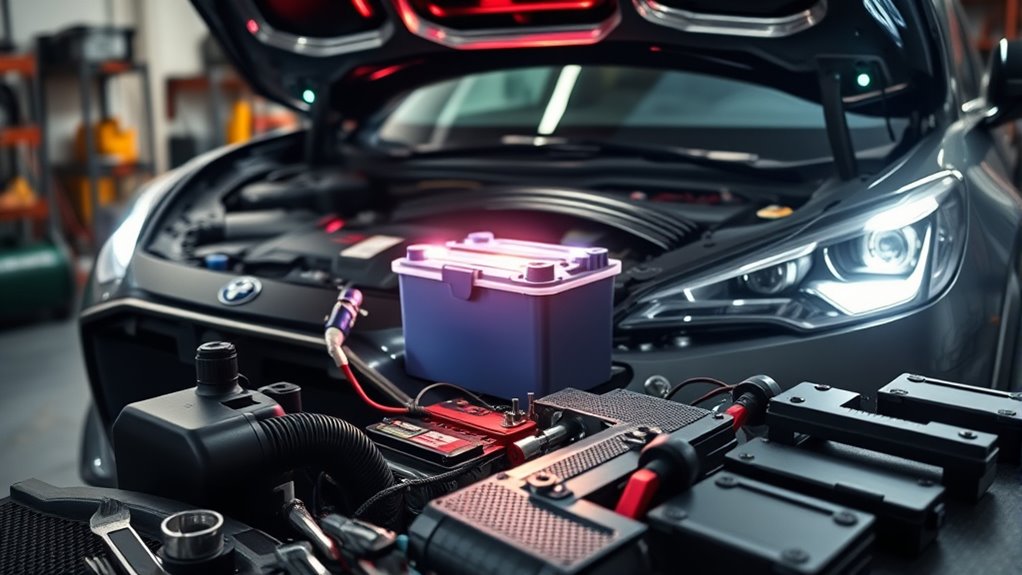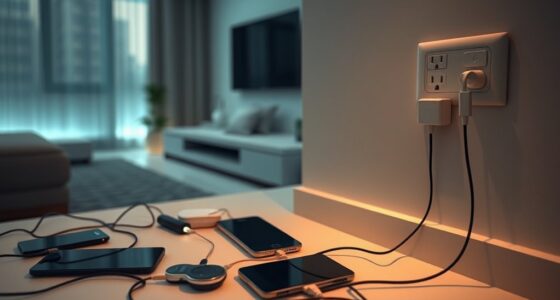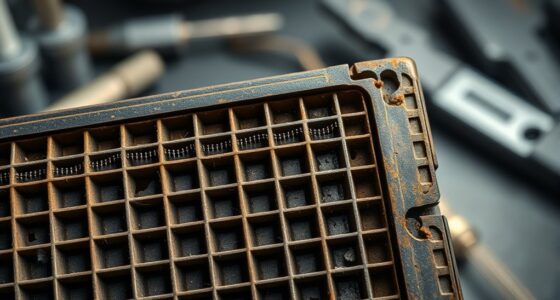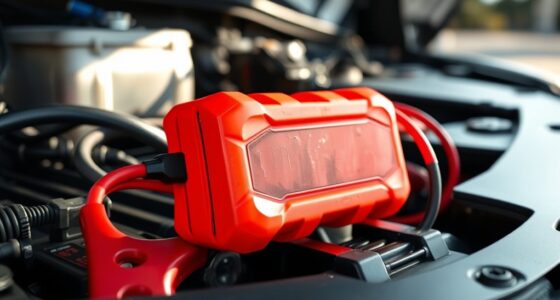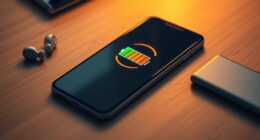Idling your car won’t really recharge a dead battery. While the alternator helps keep a healthy battery charged during normal driving, idling produces only a small amount of charge, often not enough to restore a severely drained or damaged battery. Relying on idling wastes your time and fuel without solving the core issue. If you want to understand why idling isn’t effective or learn better ways to fix your battery, keep exploring.
Key Takeaways
- Idling produces minimal charge and cannot fully recharge a severely drained or damaged battery.
- Running the engine alone is ineffective; driving the vehicle helps the alternator generate more charge.
- Jump-starting and then driving is a more reliable method to restore battery power than idling.
- Idling wastes fuel and time without addressing underlying battery issues or damage.
- Proper maintenance or replacement is often necessary if the battery is too depleted or damaged to recover through idling.
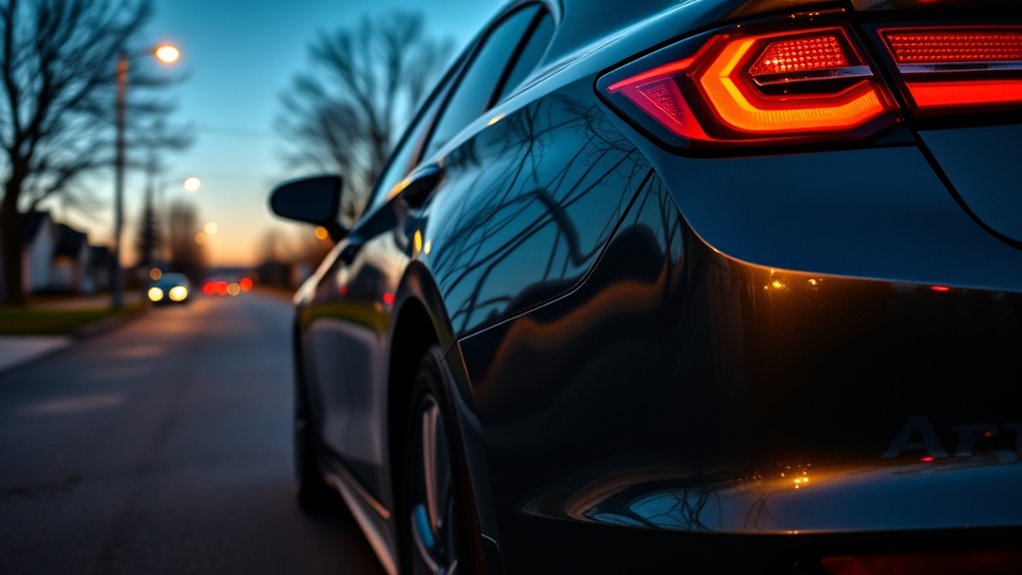
Many people believe that letting your car idle can recharge a dead battery, but in reality, this isn’t an effective solution. When your battery is completely drained, simply running the engine isn’t enough to restore its power. The alternator, which charges the battery when the engine runs, isn’t designed to do heavy lifting in this situation. Instead, it’s meant to maintain a healthy battery, not recover one that’s completely dead. Idling your car might produce a small amount of charge, but it’s usually insufficient to bring a depleted battery back to full capacity. This misconception can lead you to waste time and fuel without resolving the real issue.
If your battery is dead, your best bet is to explore alternative charging methods. Jump-starting your vehicle with jumper cables and another car, or using a portable jump starter, provides an immediate burst of power that can get your engine running. From there, you can drive your car for a while to help the alternator generate some charge. However, note that this isn’t always enough if your battery is severely depleted or damaged. In such cases, a more thorough approach, like battery repair or replacement, becomes necessary. Relying solely on idling won’t fix underlying issues like corrosion, worn-out cells, or internal damage that prevent your battery from holding a charge.
Battery repair options include cleaning corrosion on the terminals, testing the battery’s health, or replacing it altogether if it’s beyond recovery. Sometimes, a professional can perform a battery load test to determine whether repair is possible or if replacement is the better choice. This process ensures you’re not wasting your time on ineffective solutions. Remember, batteries have a limited lifespan, usually around three to five years, so if yours is old, replacing it might be the most practical and reliable solution. Additionally, understanding the role of the alternator in maintaining battery health can help you identify whether your charging system is functioning properly.
Frequently Asked Questions
Can Repeatedly Idling Damage Your Engine or Reduce Its Lifespan?
Repeatedly idling can damage your engine and reduce its lifespan. When you idle for too long, engine wear increases because parts aren’t operating efficiently, leading to more buildup and potential damage. Plus, it wastes fuel, increasing fuel consumption unnecessarily. Instead, it’s better to turn off your engine if you’re going to be stopped for a while, helping your engine last longer and saving you money on fuel.
How Long Should You Idle to Effectively Recharge a Dead Battery?
You should idle your car for about 30 minutes to give the battery enough time to recharge, but keep in mind that this depends on your battery’s health and the engine temperature. If your battery is severely dead, idling might not fully restore it. Instead, consider driving the car gently, which helps the alternator recharge the battery more effectively and maintains ideal engine temperature.
Are There Alternative Methods to Recharge a Car Battery Besides Idling?
You can recharge your dead car battery using alternatives like portable jump starters or solar panels. Portable jump starters provide a quick boost, so you don’t have to rely on idling. Solar panels can trickle charge your battery over time, making them eco-friendly options. Both methods are effective and save fuel, helping you avoid unnecessary engine running. These alternatives are practical, especially when you’re in a hurry or want to conserve energy.
Does the Type of Vehicle Affect Whether Idling Can Recharge a Dead Battery?
Your vehicle type and battery chemistry considerably influence whether idling can recharge a dead battery. For example, traditional gasoline engines may generate enough alternator power during idling, but electric or hybrid vehicles might not. If your vehicle has a high-capacity or specialized battery chemistry, idling alone might not effectively recharge it. Always consider your specific vehicle type and battery chemistry before relying on idling to restore your battery.
What Are the Signs That Indicate a Battery Needs Professional Charging or Replacement?
Think of your car battery as a tired traveler needing help. If you notice corrosion around terminals or a flashing charging indicator, it’s a sign the battery’s health is declining. Other signs include slow engine start, dim lights, or electrical issues. These clues suggest you should seek professional charging or consider replacing the battery to keep your vehicle running smoothly and avoid unexpected breakdowns.
Conclusion
So, next time your car won’t start, don’t assume idling will fix it. It’s funny how many people believe a quick run will recharge a dead battery, but in reality, it often just wastes fuel and time. Sometimes, coincidence strikes—your battery might recover on its own, or a jump-start does the trick. Just remember, proper maintenance and professional help are your best bets, not relying on chance or idle time.

